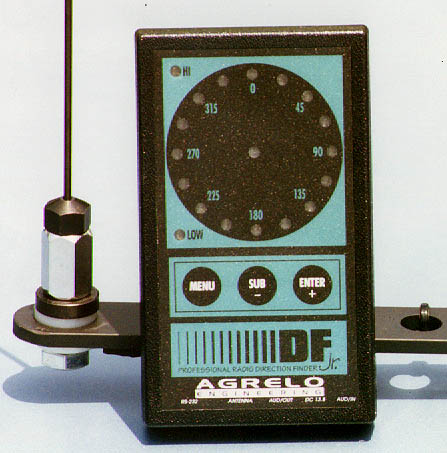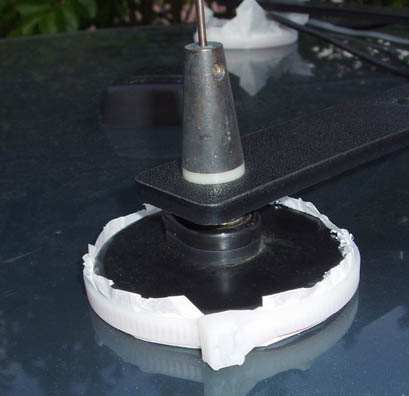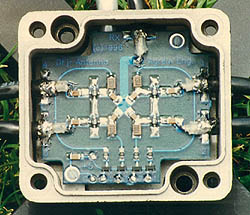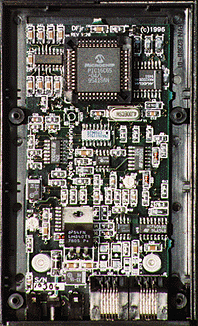
The DFjr display unit next to one of the original (Version 1) antenna whips
The DFjr is out of production. Agrelo Engineering, its designer and original manufacturer, went out of business in 1998. SWS Security, the company that bought the DFjr design from Agrelo Engineering, discontinued it in July 1999 and replaced it with The Tracker, a similar doppler set designed and priced for the commercial/military market. Then SWS Security went out of business after the death of its owner. This page is on the Homing In site to assist hams who own a DFjr or are considering the purchase of a used one.

In answer to many requests, I regret that I cannot provide schematic diagrams of the DFjr hardware (display/antenna units) or source code of the software. The manual available for download below is for Version 1.21, which was probably the last version produced by the company.
![]()
Bernie Hunt K2YO has provided a copy of the original DFjr advertisement, showing the introductory price of $299. Thanks Bernie! The antenna set pictured in the flyer is Version 1, with one large magnet in the center under the switch box.
![]()
The DFjr set that I reviewed was one of the first ten off the production line. I got it in early May 1996. As with many early-run products, there were problems, particularly in the antenna system. I reported the problems I observed to the company and closely followed the reports of others on Internet mailing lists and the corrective actions that were taken. Three major revisions and many T-hunts later, my review was complete and submitted for a two-part Homing In series to run in the May and June 1997 issues of 73 Amateur Radio Today magazine. Then the 73 editorial staff had a mind change and asked for a standalone review article instead. Many discussions followed and the end result was that the review was shortened and published in the August 1997 issue. The review article will help you determine which version of the antenna system you have and what changes, if any, need to be made to it.
![]()
In a multi-part Homing In series on Dopper RDF techniques and technology, I wrote about two ways to greatly improve the mobile performance of the DFjr: 1) increase and equalize the capacitive coupling of the four whip bases to the vehicle surface and 2) eliminate the metal crossarm. The improvements were demonstrated by actual field measurements by Mike Musick NØQBF. Read that article here.

 Q: I think I may have zapped my antenna set. How do I fix it?
Q: I think I may have zapped my antenna set. How do I fix it?
A: According to my correspondence with the engineer who designed the DFjr antenna switcher (shown at right), the monolithic RF amplifiers for the stock DFjr antenna are MAR-4 by MiniCircuits in early units and MAR-7 in later units. I have heard of some units being "souped up" with preamps from Sirenza. Any of these amps will fail if transmitted into. Some have reported failures caused by static electricity, but that hasn't happened to me.
If you can't procure MiniCircuits MAR series amplifiers, you may be able to substitute the ERA series. If you replace one amp, you should replace them all with parts from the same lot, to prevent possible phase differences between channels.
Another option would be to eliminate the preamps entirely and substitute the wide-range antenna switcher circuit in this Homing In site. I tested this switcher with a DFjr display some years ago and it worked fine. If you're concerned that my PIN switcher doesn't provide RF gain like the monolithic amplifier circuit does, keep in mind that the monolithic amplifiers have poor noise figure and their input impedance is non-optimum. (They are InGaP Darlington bipolar, not GaAsFET). So if you keep your coax to the receiver short, there will be little difference in overall performance. My passive circuit is much more tolerant of accidental transmissions, but disconnect the mike when you're DFing anyway to be safe.

This photo of the DFjr circuit board is actual size if you are using a 72 dpi monitor.
© 2004 and 2008 Joseph D. Moell. All rights reserved.

 Back to the Homing In home page
Back to the Homing In home page
This page updated 27 April 2025